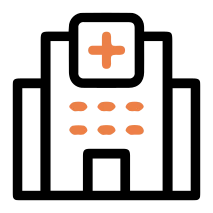Foreign body aspiration in children is a medical emergency where a solid or liquid object becomes lodged in a child’s airway, leading to partial or complete blockage of the respiratory tract. This is a frightening and potentially life-threatening situation, especially for children under the age of five, who are naturally curious and tend to put things in their mouths.
As a parent or caregiver, witnessing a child suddenly struggle to breathe can be terrifying. But with awareness, timely recognition of symptoms, and prompt medical intervention, most children recover fully without long-term effects. In this article, we’ll explore everything you need to know about foreign object inhalation in children, including its causes, symptoms, diagnostic process, and treatment options.
We’ll also use key SEO terms such as “airway obstruction in kids,” “choking in toddlers,” “aspirated foreign body treatment,” and “pediatric emergency for choking” to help this content reach those who need it most—parents, teachers, and healthcare workers.
What is Foreign Body Aspiration?
Foreign body aspiration (FBA) occurs when a child accidentally breathes an object into their airway (trachea, bronchi, or lungs), causing airflow restriction and respiratory distress. This object can be anything from a peanut or toy part to coins, beads, or even food particles.
This condition is a leading cause of unintentional injury and death in young children worldwide, especially among those under three years of age. Because of the size and anatomy of a child’s airway, even a small object can block breathing and cause severe complications if not treated promptly.
Causes of Foreign Body Aspiration in Children
Why Do Children Aspirate Objects?
Young children explore their environment using their mouths. Due to their underdeveloped swallowing coordination and the absence of molars to grind food, they are more prone to accidentally inhaling objects, particularly while laughing, talking, or playing.
Common causes of foreign body aspiration include:
- Ingesting small toys or parts (e.g., LEGO, buttons, beads)
- Eating hard or round foods (e.g., grapes, nuts, popcorn, candies)
- Lack of adult supervision during meals
- Playing with food or objects while running or talking
- Neurological or developmental disorders that impair swallowing reflex
Even older children with poor chewing habits or those with neuromuscular conditions can be at risk.
Symptoms of Foreign Body Aspiration
What Does It Look Like When a Child Aspirates?
The signs of foreign body aspiration in children can vary depending on the location and size of the object, how much of the airway is blocked, and how quickly the situation is addressed. Symptoms can be sudden and dramatic, or subtle and misleading.
Acute Symptoms (Immediate Blockage)
- Choking or gagging
- Sudden coughing
- Stridor (high-pitched wheezing)
- Cyanosis (blue lips or fingertips)
- Labored or noisy breathing
- Loss of consciousness (in severe blockage)
Chronic Symptoms (If object remains unnoticed)
- Persistent cough
- Recurrent pneumonia
- Wheezing not responding to medications
- Fever with breathing difficulty
- Voice changes
It’s important to note that not all aspirated objects cause immediate distress, making clinical suspicion vital in any unexplained or persistent respiratory issue.
Diagnosis of Foreign Body Aspiration
Clinical Evaluation and Imaging
The diagnosis of aspirated foreign body in children is often based on history and symptoms. However, in many cases, the incident may not be witnessed, making diagnosis more challenging.
Diagnostic Approaches
- Chest X-ray: May show hyperinflation, air trapping, or a visible object
- Lateral neck X-ray: Useful for high airway obstructions
- CT scan: In complex or uncertain cases
- Bronchoscopy: The gold standard; used for both diagnosis and removal
Early diagnosis significantly reduces the risk of complications such as lung abscess, pneumonia, or airway scarring.
Treatment of Foreign Body Aspiration
Emergency and Definitive Management
When a child is choking, immediate first aid is essential.
Emergency Response
- For infants (<1 year): 5 back blows + 5 chest thrusts
- For children (>1 year): Heimlich maneuver (abdominal thrusts)
If the child is unconscious or not breathing, CPR should be started and emergency services contacted immediately.
Medical and Surgical Management
Once in a medical facility:
- Oxygen therapy may be given for breathing support.
- Rigid bronchoscopy under general anesthesia is the most effective method to visualize and remove the object.
- Flexible bronchoscopy may be used in select cases.
In rare situations where bronchoscopy fails or the object has migrated, surgical removal (thoracotomy) may be necessary.
Prevention of Foreign Body Aspiration
Creating a Safer Environment for Children
The best treatment for FBA is prevention. Parents, caregivers, and schools must be vigilant in creating safe spaces for children.
Preventive strategies include:
- Avoid giving round, hard foods (like whole grapes, nuts, or popcorn) to kids under 5
- Keep small toys and batteries out of reach
- Ensure active supervision during meals and playtime
- Teach children to sit while eating and to chew thoroughly
- Perform regular toy safety checks for broken or loose parts
Raising awareness and childproofing environments can drastically reduce the incidence of foreign body aspiration in children.
Table: Partial vs Complete Airway Obstruction in Children
| Feature | Partial Airway Obstruction | Complete Airway Obstruction |
|---|---|---|
| Breathing | Labored or noisy breathing | Absent or minimal breathing |
| Cough | Present and forceful | Weak or absent |
| Voice | Hoarse or muffled | Silent cry or inability to speak |
| Cyanosis | May be absent initially | Rapidly appears |
| Consciousness | Usually maintained | Quickly deteriorates |
| Management | Medical evaluation, possible bronchoscopy | Emergency Heimlich or CPR |
Frequently Asked Questions (FAQs)
What should I do if I think my child is choking on something?
If your child is showing signs of choking, such as coughing, gagging, difficulty breathing, or turning blue, you must act quickly. For babies under one year, give five back blows followed by five chest thrusts. For children over one, perform the Heimlich maneuver by placing your hands around the child’s upper abdomen and giving quick upward thrusts. If the child becomes unconscious, start CPR and call emergency services immediately. Do not attempt to remove the object blindly with your fingers, as it may push the object deeper into the airway.
What are the signs of foreign body aspiration that may appear later?
Sometimes, a child may aspirate an object without immediate symptoms. Over time, they may develop a persistent cough, wheezing, repeated chest infections, or fever. Parents may notice that the child’s breathing sounds noisy or that they’re not responding well to asthma medications. These delayed signs can make diagnosis difficult, so if your child has ongoing respiratory issues and no clear cause, discuss the possibility of aspiration with your pediatrician.
Can a child still breathe or talk with something stuck in their airway?
Yes, in partial obstructions, children may still be able to breathe, speak, or cough. However, breathing may be noisy (stridor or wheezing), and their voice may sound different. These signs can be misleading and should not be ignored. Even if the child seems stable, foreign objects in the airway can shift and cause complete obstruction. Medical evaluation is critical even if the child appears to recover after an incident.
How is foreign body aspiration diagnosed if it isn’t seen on an X-ray?
Not all objects show up on X-rays, especially organic materials like peanuts or seeds. In such cases, doctors rely on clinical suspicion, symptoms, and advanced imaging like CT scans. Bronchoscopy is often performed even if imaging is inconclusive because it allows direct visualization and removal of the object. If your child has unexplained breathing problems, always share details of possible choking episodes with the doctor.
Is foreign body aspiration life-threatening?
Yes, especially if it leads to complete airway obstruction. Without oxygen, brain damage can occur within minutes, and death may follow. Even in cases where the obstruction is partial, complications like recurrent infections, lung collapse, or damage to lung tissue can occur. Timely intervention is essential, and educating parents and caregivers on choking first aid can save lives.
Can foreign body aspiration cause long-term lung problems?
If the object is removed quickly and the airway is not damaged, most children recover completely. However, if aspiration is unnoticed for days or weeks, it can cause lung infections, bronchiectasis (permanent airway damage), or scarring. In rare cases, children may have chronic cough or reduced lung function, requiring long-term follow-up with a pediatric pulmonologist.
Are certain objects more dangerous than others if inhaled?
Yes. Organic objects like nuts and seeds swell with moisture and may degrade, causing inflammation and infection. Sharp objects like pins or small parts can puncture or tear the airway. Batteries and magnets pose unique hazards because they can leak chemicals or cause tissue necrosis. Round, smooth items like grapes or marbles are particularly dangerous as they can cause complete obstruction.
Can my child go back to school after aspirating an object?
Once the object is safely removed and your child is breathing well, they can usually return to school within a few days. Your doctor may recommend rest or follow-up imaging depending on the severity. If there was infection or lung damage, antibiotics or breathing treatments may be prescribed. Inform school staff of any special instructions or restrictions if needed.
How can I prevent my toddler from aspirating foreign objects?
Supervision is key. Avoid giving small, hard foods like nuts, grapes, popcorn, and hard candy to children under five. Cut food into small pieces and encourage children to sit down while eating. Check toys for small detachable parts and keep items like buttons, beads, and batteries out of reach. Teach older siblings to keep their toys away from babies and toddlers.
Is bronchoscopy safe for removing foreign objects from a child’s airway?
Yes, bronchoscopy is considered safe and is the gold standard for both diagnosing and treating foreign body aspiration. It is performed under general anesthesia by a trained pediatric surgeon or pulmonologist. The success rate is very high, and complications are rare when done in a specialized center. Most children recover quickly and can go home within a day or two after the procedure.
Research References on Foreign Body Aspiration in Children
| Title of Study | Author Name |
|---|---|
| Clinical Guidelines for Airway Foreign Body Removal | Dr. Ramesh Chandra |
| Pediatric Bronchoscopy: Diagnostic and Therapeutic Roles | Dr. Sunita Patel |
| Imaging Modalities in Diagnosing Aspirated Foreign Bodies | Dr. Ajay Malhotra |
| Role of Heimlich Maneuver in Pediatric Choking Emergencies | Dr. Kavita Mehra |
| Epidemiology of Foreign Body Aspiration in Toddlers | Dr. Neeraj Sharma |
| Organic vs Inorganic Aspirates: Outcomes and Risks | Dr. Anjali Singh |
| Prevention of Airway Obstruction in Preschoolers | Dr. Manish Kapoor |
| Delayed Diagnosis of Aspirated Objects: Clinical Outcomes | Dr. Nisha Gupta |
| Complications of Undiagnosed FBA in Rural Settings | Dr. Vivek Bhalla |
| Safe Home Practices for FBA Prevention | Dr. Megha Joshi |






 and then
and then